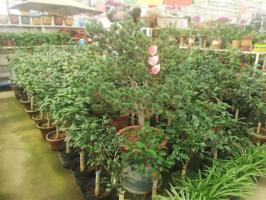How to Artificially Dry out a Potted Plant
Artificially drying out a potted plant might seem like a radical step, but sometimes it’s necessary to save the life of your plant. Over-watering can be a common mistake made by new or inexperienced gardeners, and it can quickly lead to root rot and death of the plant. If you’ve accidentally over-watered your potted plant, it’s important to take immediate action. Here’s how to artificially dry out your potted plant:
Step 1: Remove the Pot
The first step in artificially drying out your potted plant is to remove it from the pot. Carefully lift the plant out of the pot, and gently shake off any excess soil. Be sure to be gentle with the roots, because they will still be fragile even if they are struggling with too much moisture.
Step 2: Assess the Damage
Once the plant has been removed from its pot, you’ll be able to assess the damage. Look for any signs of rot, such as slimy or blackened roots. If the roots are severely damaged, the plant may not be recoverable. However, if there are only a few damaged roots, it may still be possible to save the plant.
Step 3: Remove Dead and Damaged Roots
If the roots are only mildly damaged, then you’ll need to remove any dead or damaged roots. Cut them away from the healthy roots using a pair of sharp, sterile pruning shears. Be sure to disinfect the shears before and after use to avoid introducing any further infection to the plant.
Step 4: Repot in Dry Soil
Once you’ve removed any diseased or dead roots, you need to repot the plant in dry soil. Choose a well-draining potting mix that is specifically designed for your plant type. Gently work the dry soil around the roots, being careful to avoid damaging any more of them. Once the roots are covered with soil, water the plant lightly.
Step 5: Wait
After the plant has been repotted and watered, you’ll need to wait. Resist the urge to water the plant again, as this will only worsen the situation. Instead, place the pot in a dry, well-ventilated area with indirect sunlight. Depending on the severity of the over-watering, it may take a week or more for the plant to return to normal. Be patient and allow the plant time to recover.
Conclusion
Artificially drying out a potted plant is a delicate process, but it’s necessary in some cases to save your plant’s life. By following these steps, you can help your plant to recover from over-watering and root rot. Remember, prevention is always better than cure, so be sure to avoid over-watering your potted plants in the future.

 how many times do yo...
how many times do yo... how many planted tre...
how many planted tre... how many pine trees ...
how many pine trees ... how many pecan trees...
how many pecan trees... how many plants comp...
how many plants comp... how many plants can ...
how many plants can ... how many plants and ...
how many plants and ... how many pepper plan...
how many pepper plan...































